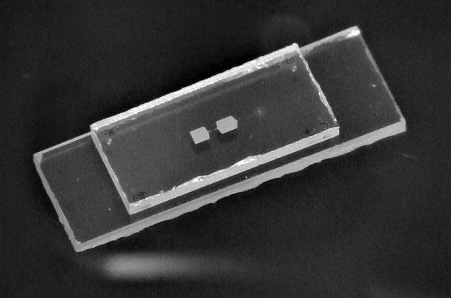Enter the Mechanical Qubit
Researchers at the Swiss Federal Institute of Technology (ETH) Zurich have demonstrated that a mechanical oscillator can function as a qubit, the fundamental building block of a quantum computer [1]. Yiwen Chu and her colleagues showed that the vibrational modes of an acoustic resonator can form long-lived qubit states. The mechanical qubit could lead to new kinds of quantum processors as well as novel ways of testing the interaction of gravity with quantum mechanics.
A qubit can be created from any system with two distinct quantum states, such as a pair of electronic energy levels in an atom, with one state corresponding to the 0 and the other to the 1 of conventional digital electronics. Unlike a classical circuit, however, such a system can exist in either one of these states or in a quantum superposition of the two. Putting qubits into these superposition states allows a quantum computer to examine a vast number of potential solutions at the same time, yielding the fabled quantum leap in processing power.
But the full promise of quantum computers has yet to be realized, in part, because the quantum superpositions of typical qubits have lifespans, or coherence times, that are too short for performing complex calculations. This bottleneck has prompted researchers to investigate the possibility of creating a qubit from an acoustic resonator, in which the quantum states are mechanical oscillations that can vibrate millions or even billions of times before dying out.
The problem is that the energy structure of these quantized vibrations, called phonons, makes it challenging to create a useful qubit. In conventional qubits the transitions between the two states can be selectively manipulated by an electromagnetic wave at a specific frequency, without affecting other excitations of the system. In contrast, a mechanical oscillator has many energy states that are spaced evenly apart, which means that radiation exciting a transition between two states also triggers other transitions between higher-energy states. This even spacing, or “harmonicity,” makes it impossible to isolate and control transitions between a single pair of quantum states.
To overcome this problem researchers have previously designed hybrid systems in which the mechanical resonator is coupled to another quantum system with an anharmonic energy structure. In 2023, for instance, Adrian Bachtold from the Institute of Photonic Sciences (ICFO) in Spain and colleagues coupled a carbon nanotube to a quantum dot, showing that the combined system became significantly anharmonic at low temperatures [2]. However, rapid decoherence prevented the system from acting as a mechanical qubit.
Chu’s team has instead coupled a superconducting qubit—with its inherent advantages of long coherence times and established control methods—to a bulk acoustic resonator consisting of a sapphire crystal a few hundred micrometers thick. The superconducting circuit is patterned onto another slab of sapphire positioned just below the resonator, with the coupling achieved through a small disk of piezoelectric material that deforms in response to the qubit’s electric field.
In previous work Chu and her team showed that this configuration enables quantum control of the acoustic resonator, including the preparation of specific quantum states [3]. In the new study they have reengineered the system to create hybridized states that retain the quantum properties of the mechanical system but inherit the anharmonic nature of the superconducting qubit. To create these “dressed” states, the researchers worked on two fronts. First, they improved their fabrication techniques to enhance the coherence times of both the mechanical and superconducting elements. Second, they tuned the frequency of the vibrations to be almost resonant with the operating frequency of the superconducting qubit. “[That’s] a smart way to achieve much stronger coupling between the superconducting qubit and the bulk acoustic vibrations,” commented Bachtold, who was not involved in the work.
In their experiments Chu and colleagues showed that the two lowest-energy states of this hybrid system were distinct enough to operate as qubit states that can be controlled through the superconducting circuit. The combined system also achieves a coherence time of 200 µs, compared with 20 µs for the superconducting qubit on its own. The researchers suggest that further improvements could be made by optimizing the geometry of the device.
The team is now keen to show that a pair of mechanical qubits can be used to perform simple logic operations. The extra mass of the mechanical system also promises to provide a sensitive atomic-scale probe of forces such as gravity. “A qubit with a mechanical degree of freedom is uniquely suited for exploring new directions, such as measuring gravity and its interplay with quantum mechanics,” says Chu.
–Susan Curtis
Susan Curtis is a freelance science writer based in Bristol, UK.
References
- Y. Yang et al., “A mechanical qubit,” Science 386, 783 (2024).
- C. Samanta et al., “Nonlinear nanomechanical resonators approaching the quantum ground state,” Nat. Phys. 19, 1340 (2023).
- S. Marti et al., “Quantum squeezing in a nonlinear mechanical oscillator,” Nat. Phys. 20, 1448 (2024).





